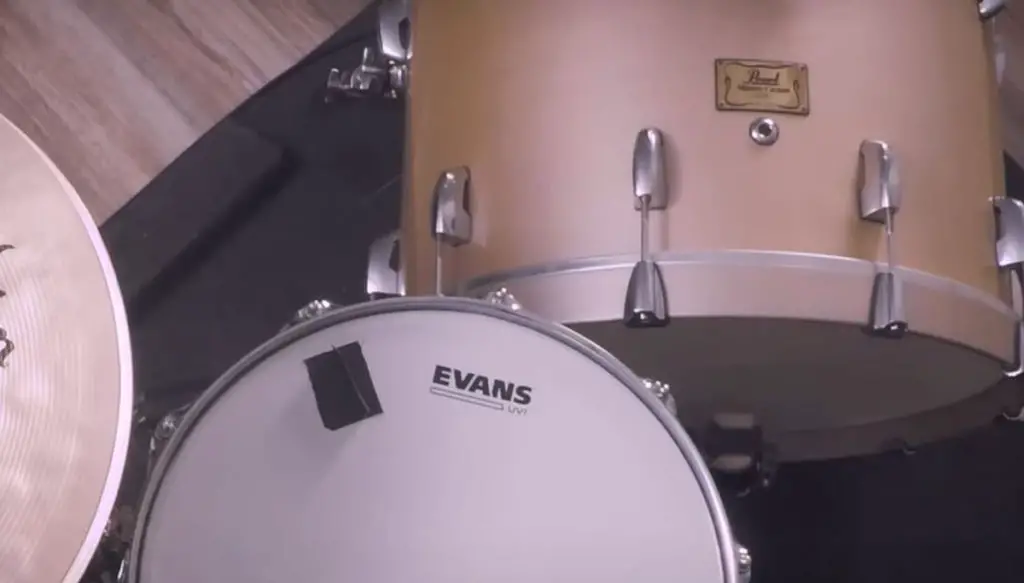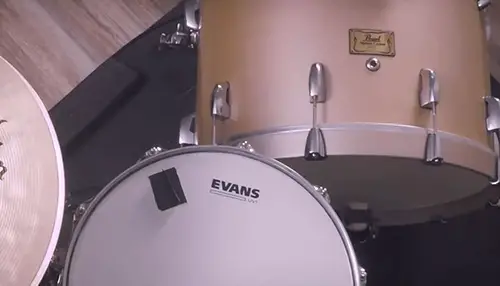If you’ve ever seen a drum set covered in tape, you may be wondering why someone would decide to do that. The process of putting tape on drums is called ‘dampening,’ and it has different effects depending on the drum and where the tape is placed. It is also referred to as ‘muting,’ ‘muffling,’ ‘damping,’ or ‘choking.’
Putting tape on drums helps control the sounds the drums make by making the drum quieter or by reducing the ringing of the drum or cymbal. Taping your drums can also compensate for different acoustics in a variety of environments.

One of the most common reasons people put tape on their drums is because it makes them quieter. Think about all those parents yelling at their kids to keep it down. Or, playing a small venue where the drums dominate the sound.
Tape can also be used to help match the sound of your drums to the sound of a particular track or artist. There are dozens of reasons that one might want to dampen a drum with tape. A live show without microphones might require different dampening than a recording session where your drums have lots of microphones around them, picking up different ranges of sound.
Techniques to Dampen Your Drums
Drummers put tape on their drums to help dampen the sound, lessen the sustain, and rid high-frequency overtones.
Tape generally makes the volume lower, but it can influence the sound of the drums in a wide variety of ways. There are many ways to dampen a drum, but tape is generally the easiest, cheapest, and most handy to find.
You can also use tape in conjunction with other items, such as cardboard, to dampen the sound further. It may take a lot of experimentation with different types of tuning and dampening to find your perfect sound.
I do recommend experimenting with the tape while at home. That way while you are at a venue and the drums have a different sound due to the room’s acoustic, you will be prepared and know how and where to tape the drums to fix the sound.
Some companies make products specifically for drum dampening, such as the D DOLITY Dampening Rings Set, which removes overtones, or RTOM Damper Pads that are self-adhesive and made from non-toxic gel.
These are good alternatives to tape if they work to get your desired sound and you have the money to spend. Find an experienced drummer, perhaps the drum guy at your local music store, and ask them which product might be right for your needs.
One more factor to consider is that different drums are affected differently by dampening. Drums have various build sizes qualities, sizes, types of wood, and other factors that give them their unique timbre. This will also change how they should be dampened.
One of the most commonly dampened drums is the bass drum since it’s often very loud and tends to ring. Some drummers put entire blankets inside the drum itself to dampen the sound. A sound engineer in a recording studio will almost certainly want you to do this.
Related Article: What Does Putting a Pillow In a Kick Drum Do?
Dampening also has different effects based on the material of the drum itself. A snare made of poplar will require different dampening than a snare made from maple, for example.
Should I Put Tape on My Drums?
Not every situation will call for drum dampening. However, dampening can usually give you a different sound if you don’t like something about the tone. If a drum kit is appropriately tuned, you might not even need to dampen the sound at all.
A heavy tape should be used on drums to dampen the sound and reduce overtones. Gaffers tape is recommended as it does not leave a sticky residue.
Common heavy tape such as duct tape can sometimes leave residue on your drum head or damage the drum skin if pulled off too forcefully.
If you’re taking your drum kit to record in a studio, it’s a good idea to come prepared. Some recording studios will have their own products and solutions to help dampen your drums, but you should bring some of your own dampening tools (such as tape) just in case.
Some drum heads, such as the Remo Pinstripe Drumhead, are made with extra dampening built right into the drum head itself. The most common variation of this is the two-ply drum head.
Obviously, different types of drum heads will require different types of dampening. The more layers the drum head has, the more muffling quality it naturally has.
How Do You Dampen a Drum With Tape?
There are many ways to dampen drums, but one of the most common methods is with tape. Taping your drums is a great way to dampen them. You can use tape on the outside of the drum, or inside on the head.
In general, one of the most common ways to dampen a drum with tape is to place a small piece of gaffers tape on the edge of the drum head near the rim, but not touching the rim. Tape can also be added closer to the center of the drum or even on the drum’s resonant head (bottom head).
All of these methods will affect the sound differently. It’s a good idea to experiment with your dampening to see how the tape affects your sound in different situations.
Here are the basic steps to dampen a drum with tape:
- Make sure the drum is tuned to your desired pitch and resonance. The tension should be the same for every lug around the edge of the drum head.
- Listen to your drum. Decide whether or not you like the sound and what you’d like to change about it. You might want to make it quieter, or you might want to downplay some of the higher frequencies. It’s all about experimenting with personal preference.
- Start by cutting about 2 cm (0.79 in) of electrical tape or gaffer tape. Apply the tape directly to the head near the edge of the drum.
- Listen to the drum again. The tape should make the drum quieter and less resonant. If you like the way it sounds, you’re done! However, you can experiment further to change the sound more.
- Repeat steps 3 and 4 as needed. Placing the tape closer to the center will dampen the drum more. You can also add more tape or tape a folded piece of paper or cardboard for more dampening.
- Experiment with the tape until the drum sounds the way you want it to sound. There’s no ‘right’ or ‘wrong’ for this process, as long as you aren’t damaging the drum head or the hardware.
Good drummers constantly play with their drums to figure out how they sound in different contexts. Getting a feel for how your drums react to tape and other forms of dampening will give you a lot more control over how your instrument sounds.
This article only covers dampening drums using tape, but there are many ways to dampen a drum. Drumheadauthority.com has a in depth article on dampening techniques. I also recommend watching these videos for learning different methods for using tape.
What Does Tape Do to Cymbals?
Much like with drum heads, cymbals can also be dampened using tape. However, instead of being called ringing out, it is called the wash.
Tape placed on a cymbal will reduce the sound that builds up from striking the cymbal repeatedly, known as the “wash”. This can give the drummer a more controlled sound interms of volume.
In some situations, particularly in live and recording performances, many cymbals, particularly new clean ones, have a lot of hiss, wash, and other overtones that are undesirable.
Related Content: Why Do Drummers Use Rugs? What Does a Drum Rug Do?
Final Thoughts
Taping your drums is a cheap and straightforward way to change their sound without tuning them differently or buying expensive products. Experimenting with your drums is something that every drummer should do from time to time.
This process of experimentation gives you a chance to learn how your drums will sound in different situations and gives you more control over the sound of your instrument.
If you’re curious about drum dampening, using tape is one of the cheapest and most versatile ways to do it. Moongels are another great option to have in your gig bag as an alternative.

